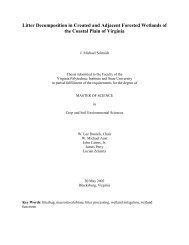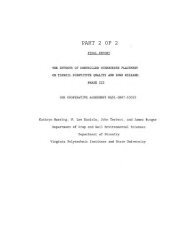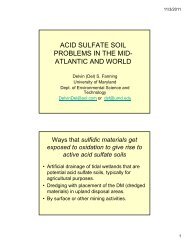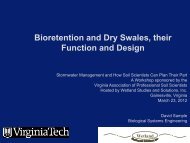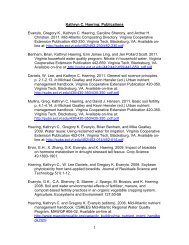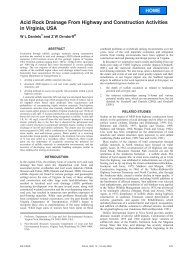Remediation of PAH-Contaminated Soils and Sediments: A ...
Remediation of PAH-Contaminated Soils and Sediments: A ...
Remediation of PAH-Contaminated Soils and Sediments: A ...
Create successful ePaper yourself
Turn your PDF publications into a flip-book with our unique Google optimized e-Paper software.
transition phase between slurried sediments <strong>and</strong> soils, as well as set more<br />
realistic guidelines for cleanup. Beyond the previously described differences,<br />
state regulations <strong>and</strong> st<strong>and</strong>ards vary based on the intended beneficial use<br />
(beach nourishment, compost/topsoil, final cover at a l<strong>and</strong>fill or superfund site,<br />
residential or industrial uses, or aggregate/fill) <strong>of</strong> a given dredge sediment.<br />
In the states <strong>of</strong> the Great Lakes Commission (Illinois, Indiana, Michigan,<br />
Minnesota, New York, Ohio, Pennsylvania <strong>and</strong> Wisconsin), there is also a<br />
regional framework <strong>of</strong> guidelines <strong>and</strong> st<strong>and</strong>ards to aide in the proper<br />
management <strong>and</strong> beneficial use <strong>of</strong> dredged sediments (GLC, 2004). Currently,<br />
dredge sediments are considered a waste product rather than a resource (GLC,<br />
2004). One <strong>of</strong> the goals <strong>of</strong> the Great Lakes Commission (GLC) is to combine<br />
knowledge from existing case studies, policy, guidance, <strong>and</strong> regulations to utilize<br />
dredge sediments as a resource, especially in upl<strong>and</strong> placement settings.<br />
Risk Assessment<br />
Contaminants, including <strong>PAH</strong>s, are assessed for risk based on their toxicity <strong>and</strong><br />
exposure. Low molecular weight <strong>PAH</strong>s are considered directly toxic (Sims <strong>and</strong><br />
Overcash, 1983) <strong>and</strong> HMW <strong>PAH</strong> compounds are considered genotoxic, or<br />
capable <strong>of</strong> causing damage to DNA (Lijinsky, 1991). Toxicity is mainly the result<br />
<strong>of</strong> <strong>PAH</strong> metabolic transformations in the human body into a complex mix <strong>of</strong><br />
quinones, quinines, cis- <strong>and</strong> trans-dihydrodiols, phenols, epoxides <strong>and</strong> other<br />
oxidized metabolites depending on the hydrocarbon <strong>and</strong> the metabolic route<br />
(Harvey, 1997; Dabestani <strong>and</strong> Ivanov, 1999; Volkering <strong>and</strong> Breure, 2003). Some<br />
<strong>of</strong> these reactive metabolic intermediates can covalently bind to nucleic acids to<br />
induce str<strong>and</strong> breaks <strong>and</strong> DNA damage, leading to mutation <strong>and</strong> tumor initiation<br />
(Harvey, 1997). The carcinogenic <strong>and</strong> mutagenic potential <strong>of</strong> <strong>PAH</strong>s depends on<br />
their metabolites.<br />
Humans can be exposed to both directly toxic <strong>and</strong> genotoxic compounds through<br />
ingestion, inhalation, <strong>and</strong> dermal exposure (i.e. drinking contaminated water,<br />
consumption <strong>of</strong> plants or animals that have come in contact with the<br />
contaminant, breathing <strong>PAH</strong> particulates, or holding <strong>PAH</strong> contaminated soil in<br />
your h<strong>and</strong>). Once humans come in contact with the <strong>PAH</strong> compound, it is<br />
distributed, metabolized, stored in the human body or excreted. Once in the<br />
human body, the <strong>PAH</strong>s can impact the respiratory, reproductive, <strong>and</strong><br />
neurological systems, cause birth defects, <strong>and</strong> cancer (Figure 13).<br />
67



